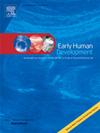Quantitative analysis of fetal cardiac structure and function in gestational diabetes mellitus using fetal HQ technology
IF 2.2
3区 医学
Q2 OBSTETRICS & GYNECOLOGY
引用次数: 0
Abstract
Background
Gestational diabetes mellitus (GDM) can contribute to changes in fetal cardiac structure and function, with potential implications for long-term cardiovascular health. This study focuses on assessing these cardiac adaptations in fetuses from GDM pregnancies by using the innovative Fetal Heart Quantification (Fetal HQ) technology to provide a detailed evaluation of structural and functional parameters.
Methods
A prospective study was conducted from March 2023 to October 2024 at Xiangyang No.1 People's Hospital, involving 382 pregnant women in their second and third trimesters, including 167 with GDM and 215 healthy controls. Fetal cardiac assessments were performed using Fetal HQ, which allows for direct measurement of cardiac deformation and function. Key parameters such as left ventricular (LV) and right ventricular (RV) dimensions, global longitudinal strain (GLS), and fractional area change (FAC) were analyzed. Maternal clinical data, including blood glucose levels and body mass index (BMI), were also collected. Statistical analyses were performed to compare the cardiac parameters between the two groups.
Results
Significant differences were observed in fetal cardiac dimensions, with the GDM group exhibiting larger LV end-diastolic area (2.04 ± 0.73 cm2 vs. 1.81 ± 0.69 cm2, p = 0.002) and lower RV GLS (−20.1 ± 5.3 % vs. -22.6 ± 4.6 %, p = 0.000). Other functional parameters, including LV GLS and FAC, did not show significant differences between groups. Correlation analysis revealed a significant positive relationship between maternal HbA1c levels and RV FAC (r = 0.348, p = 0.036), indicating that maternal glycemic control may influence fetal cardiac function.
Conclusions
The findings suggest that GDM is associated with altered fetal cardiac morphology, particularly in the left ventricle, and impaired right ventricular function, as evidenced by reduced GLS. These results highlight the potential impact of maternal hyperglycemia on fetal cardiac development and underscore the importance of monitoring fetal cardiac health in pregnancies complicated by GDM. The use of Fetal HQ technology provides a valuable tool for early detection of cardiac dysfunction in this high-risk population.
应用胎儿HQ技术定量分析妊娠期糖尿病胎儿心脏结构和功能。
背景:妊娠期糖尿病(GDM)可导致胎儿心脏结构和功能的改变,对长期心血管健康有潜在影响。本研究的重点是通过使用创新的胎儿心脏量化(胎儿HQ)技术来评估GDM妊娠胎儿的这些心脏适应性,以提供详细的结构和功能参数评估。方法:于2023年3月至2024年10月在襄阳第一人民医院开展前瞻性研究,纳入382例妊娠中晚期孕妇,其中GDM 167例,健康对照215例。胎儿心脏评估使用胎儿HQ进行,这允许直接测量心脏变形和功能。分析左心室(LV)和右心室(RV)尺寸、整体纵向应变(GLS)和分数面积变化(FAC)等关键参数。还收集了产妇的临床数据,包括血糖水平和体重指数(BMI)。对两组心脏参数进行统计学分析比较。结果:两组胎儿心脏尺寸差异有统计学意义,GDM组左室舒张末期面积较大(2.04±0.73 cm2比1.81±0.69 cm2, p = 0.002),左室GLS较低(-20.1±5.3%比-22.6±4.6%,p = 0.000)。其他功能参数,包括LV GLS和FAC,组间无显著差异。相关分析显示母体HbA1c水平与RV FAC呈显著正相关(r = 0.348, p = 0.036),提示母体血糖控制可能影响胎儿心功能。结论:研究结果表明,GDM与胎儿心脏形态改变(尤其是左心室)和右室功能受损有关,GLS降低证明了这一点。这些结果强调了母体高血糖对胎儿心脏发育的潜在影响,并强调了监测妊娠合并GDM胎儿心脏健康的重要性。胎儿HQ技术的使用为这一高危人群早期发现心功能障碍提供了一个有价值的工具。
本文章由计算机程序翻译,如有差异,请以英文原文为准。
求助全文
约1分钟内获得全文
求助全文
来源期刊

Early human development
医学-妇产科学
CiteScore
4.40
自引率
4.00%
发文量
100
审稿时长
46 days
期刊介绍:
Established as an authoritative, highly cited voice on early human development, Early Human Development provides a unique opportunity for researchers and clinicians to bridge the communication gap between disciplines. Creating a forum for the productive exchange of ideas concerning early human growth and development, the journal publishes original research and clinical papers with particular emphasis on the continuum between fetal life and the perinatal period; aspects of postnatal growth influenced by early events; and the safeguarding of the quality of human survival.
The first comprehensive and interdisciplinary journal in this area of growing importance, Early Human Development offers pertinent contributions to the following subject areas:
Fetology; perinatology; pediatrics; growth and development; obstetrics; reproduction and fertility; epidemiology; behavioural sciences; nutrition and metabolism; teratology; neurology; brain biology; developmental psychology and screening.
 求助内容:
求助内容: 应助结果提醒方式:
应助结果提醒方式:


